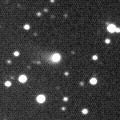
|
Although it was faint as 16.4 mag at the discovery in March (Mar. 12, R. H. McNaught), then it brightened well as expected, and now it is 11.3 mag (Nov. 4, Juan Jose Gonzalez). Strongly condensed and easy to see. It was very small and sharp before, however, the coma is getting larger and it looks like an ordinary comet now. It will reach to 10 mag from January to March. In the Southern Hemisphere, it is observable only until December. In the Northern Hemisphere, the altitude will be getting lower slowly after January, and it will be too low to observe in April.
Date(TT) R.A. (2000) Decl. Delta r Elong. m1 Best Time(A, h)
Nov. 5 20 3.07 -27 28.8 2.163 2.128 74 11.4 20:07 ( 88, 50)
Nov. 12 20 13.49 -26 0.1 2.178 2.067 70 11.2 20:17 ( 87, 44)
|

|
It was expected to reach to 9 mag in 2006 spring. But actually, it is much fainer than expected, 13.9 mag on Aug. 1 and 11.7 mag still on Oct. 27 (Michael Mattiazzo). It seems to be a comet with very slow brightness evolution, similar to C/2003 T4. It will be 11 mag at best. It is not observable until late March in the Northern Hemisphere, but will be observable for a long time while it is getting fainter after that. It will be too low even in the Southern Hemisphere from January to February.
Date(TT) R.A. (2000) Decl. Delta r Elong. m1 Best Time(A, h)
Nov. 5 2 19.18 -86 18.1 2.000 2.041 78 11.7 22:48 ( 0, 39)
Nov. 12 21 41.57 -84 0.4 2.030 1.986 73 11.6 20:17 ( 4, 40)
|
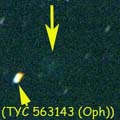
|
New comet discovered in the SWAN images. Revealed as a periodic comet with a period of 27 years. It has already passed the perihelion on Oct. 10. It has been fading as 9 mag on Oct. 9 and 10 mag on Oct. 13 in the SWAN images. It faded down to 12.6 mag on Oct. 24 (Seiichi Yoshida). In the Northern Hemisphere, it is observable in the evening low sky, but it will be fade out rapidly. Because it is diffuse, it will be too hard to see soon. It will be too low in mid November. It must have been brightening in the morning sky from August to September, but it was missed.
Date(TT) R.A. (2000) Decl. Delta r Elong. m1 Best Time(A, h)
Nov. 5 16 41.90 -11 34.0 1.525 0.826 29 13.1 20:07 ( 77, 2)
Nov. 12 16 44.75 -12 20.2 1.728 0.914 23 13.8 20:17 ( 71, -5)
|

|
It had been so faint as around 15 mag for a long time since May. It had been too faint to see visually. However, after an outburst occured on Sept. 9 when it brightened to 13 mag (Stephane Garro), it keeps bright enough to be visible visually around 13 mag. Very diffuse if not in outburst, but visible visually as 12.8 mag (Oct. 24, Seiichi Yoshida). Another outburst occured on Nov. 2, and it was condensed and bright bright as 12.5 mag (Piotr Guzik).
Date(TT) R.A. (2000) Decl. Delta r Elong. m1 Best Time(A, h)
Nov. 5 1 57.17 23 59.3 4.799 5.768 166 13.1 22:57 (180, 31)
Nov. 12 1 53.93 23 39.5 4.822 5.770 161 13.1 22:26 (180, 31)
|

|
Although it has already passed the perihelion in 2004 October, the fading after the perihelion passage is slow. It is visible visually still now, bright as 13.1 mag (Oct. 24, Seiichi Yoshida). Moderately condensed and easy to see. Because it is distant from the sun, it can be visible visually as 13 mag for a while after this.
Date(TT) R.A. (2000) Decl. Delta r Elong. m1 Best Time(A, h)
Nov. 5 3 26.74 -12 22.5 4.141 5.022 149 13.7 0:31 (180, 67)
Nov. 12 3 18.32 -12 33.2 4.211 5.090 149 13.8 23:50 (180, 68)
|
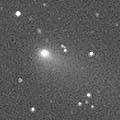
|
Although it was reported so faint as 16-20 mag at the discovery in September, it is actually much brighter, around 14 mag. It was also visible visually as 13.6 mag (Sept. 25, Werner Hasubick). Then it brightened furthermore, 12.8 mag on Oct. 25 (Seiichi Yoshida). It keeps observable in good condition until winter. It must have been observable as 14-15 mag in 2004 spring and summer, but it was not discovered at that time. Therefore, now it may be in an unusual temporary outburst. Actually, no sign to fade out has been observed yet, so it will be visible bright as 13 mag for a while after this.
Date(TT) R.A. (2000) Decl. Delta r Elong. m1 Best Time(A, h)
Nov. 5 1 47.44 27 53.6 1.825 2.787 162 13.8 22:47 (180, 27)
Nov. 12 1 42.19 27 11.5 1.872 2.814 157 14.0 22:15 (180, 28)
|
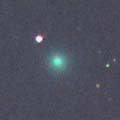
|
New comet discovered by many people in the SWAN images released in late August. It was bright as 9.5 mag visually (Aug. 25, Alan Hale). It has already passed the perihelion on Aug. 9, and it faded rapidly in September. Now it faded down to 13.2 mag (Oct. 24, Seiichi Yoshida). Because it is very diffuse, it was reported faint around 15 mag by CCD observations. It keeps observable in good condition for a while after this. However, because it is very diffuse, it will be too hard to see visually soon.
Date(TT) R.A. (2000) Decl. Delta r Elong. m1 Best Time(A, h)
Nov. 5 6 52.63 79 40.4 1.168 1.772 110 13.8 3:20 (182,-25)
Nov. 12 4 27.53 77 49.7 1.185 1.877 119 14.1 1:10 (180,-23)
|
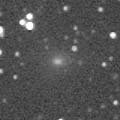
|
It reached to 11.4 mag in August (Aug. 12, Juan Jose Gonzalez). It was expected to start fading since early September. But actually, it keeps bright as 11.8 mag still on Oct. 7 (Juan Jose Gonzalez). However, it was not observed visually these days. Althought it had been very low in the morning for a while, it is getting higher gradually after this. However, it is getting fainter after this, and it will be fainter than 14.5 mag in late November when the altitude becomes higher than 30 degree. In the Southern Hemisphere, it is unobservable until December.
Date(TT) R.A. (2000) Decl. Delta r Elong. m1 Best Time(A, h)
Nov. 5 12 48.34 14 7.9 2.241 1.623 40 13.9 3:20 (263,-14)
Nov. 12 12 57.48 11 38.7 2.270 1.698 43 14.1 3:11 (263,-11)
|

|
It brightened from 18 to 15 mag from the end of 2003 to early 2005. The brightness evolution was much faster than that of a typical comet. Then it continues brightening fast as expected, and it is already visible visually as 13.5 mag (Oct. 24, Seiichi Yoshida). Small and strongly condensed.
Date(TT) R.A. (2000) Decl. Delta r Elong. m1 Best Time(A, h)
Nov. 5 9 48.28 46 3.4 5.232 5.324 89 14.0 3:20 (214, -4)
Nov. 12 9 53.80 46 26.7 5.130 5.313 95 13.9 3:11 (212, -3)
|

|
It was fantastic, so bright as 3.5 mag, so large as 30 arcmin, locating high overhead at its best time in early January. Then it has been getting fainter and smaller gradually, 12.5 mag on Sept. 3 (Edwin van Dijk) and 13.8 mag on Oct. 19 (Mitsunori Tsumura). It will be too low in the evening sky soon. But it will appear again in the morning sky at 15 mag in December, then it keeps observable using CCD cameras until next summer.
Date(TT) R.A. (2000) Decl. Delta r Elong. m1 Best Time(A, h)
Nov. 5 15 35.04 3 34.8 4.790 3.901 23 14.3 20:07 ( 79,-21)
Nov. 12 15 42.40 2 52.7 4.872 3.972 22 14.4 20:17 ( 74,-26)
|

|
It passed the perihelion on Apr. 10 and reached to 8 mag in the southern sky. Then it has been fading, but it is visible visually still now as 13.5 mag (Oct. 25, Seiichi Yoshida). The nucleus was split into two components and it has a broad long dust tail. It looks diffuse visually. It will be fading slowly, but it keeps locating high until December.
Date(TT) R.A. (2000) Decl. Delta r Elong. m1 Best Time(A, h)
Nov. 5 22 17.77 25 23.7 2.618 3.209 118 14.7 20:07 (167, 29)
Nov. 12 22 15.70 24 49.1 2.786 3.289 112 14.9 20:17 (158, 27)
|
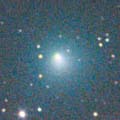
|
It kept bright as 10 mag from May to August, and it was still bright as 10.9 mag on Aug. 5 (Seiichi Yoshida). Then it has been fading, and it faded down to 13.9 mag on Oct. 1 (Mitsunori Tsumura). It is already very low in the evening in the Northern Hemisphere, and few observations have been reported recently. But it keeps observable in the Northern Hemisphere locating very low in the evening until December with an altitude of aroud 17 degree. In the Southern Hemisphere, it keeps locating high until November.
Date(TT) R.A. (2000) Decl. Delta r Elong. m1 Best Time(A, h)
Nov. 5 19 19.13 -31 1.5 2.113 1.914 64 14.7 20:07 ( 78, 43)
Nov. 12 19 38.22 -30 20.7 2.210 1.952 62 15.0 20:17 ( 77, 39)
|

|
Recovery of a peculiar asteroid 2004 FS101 discovered in 2004 spring. Although it was 18 mag in mid January, it has been brightening rather faster than a typical comet, and it reached to 16 mag in early September. It will be 14.5 mag around 2006 January. It keeps observable at 15-16 mag for a long time from 2005 spring to the end of 2006. Because it moves in the northern sky, it keeps observable for a long time in the Northern Hemisphere. However, it will be rather low when the comet becomes brightest. It was not visible visually, fainter than 14.0 mag on Aug. 5 (Seiichi Yoshida), when the altitude was high.
Date(TT) R.A. (2000) Decl. Delta r Elong. m1 Best Time(A, h)
Nov. 5 15 32.20 47 46.4 3.682 3.375 64 15.0 20:07 (126,-40)
Nov. 12 15 48.74 48 12.2 3.625 3.355 66 15.0 20:17 (126,-43)
|
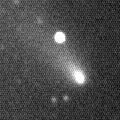
|
Although it became brightest about 2 weeks before the perihelion passage in its last appearance in 1998, it kept brightening until the perihelion passage in this return, and reached to 9.2 mag on July 2 (Carlos Labordena). It is fading rapidly after that, and reached down to 13.2 mag on Oct. 11 (Michael Mattiazzo). It will be fading while locating around 30 degree high after this in the Northern Hesmisphere.
Date(TT) R.A. (2000) Decl. Delta r Elong. m1 Best Time(A, h)
Nov. 5 8 47.78 -18 46.3 1.743 1.903 83 15.1 3:20 (254, 53)
Nov. 12 8 51.55 -20 37.4 1.739 1.966 87 15.3 3:11 (253, 57)
|
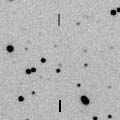
|
Although it was faint as 18 mag at the discovery in 2004 November, then it brightened very rapidly until early 2005, and reached to 16.0 mag on May 7 (Ken-ichi Kadota). It appeared at dawn again now. It was 15.2 mag on Sept. 30 (Ken-ichi Kadota), so it continued brightening as expected. After this, it keeps bright as 15 mag for a long time until 2006 spring. In the Northern Hemisphere, it keeps observable in good condition until 2006 summer when it becomes too faint.
Date(TT) R.A. (2000) Decl. Delta r Elong. m1 Best Time(A, h)
Nov. 5 12 3.93 17 34.5 2.929 2.429 50 15.2 3:20 (254, -7)
Nov. 12 12 16.74 16 39.7 2.879 2.441 54 15.2 3:11 (254, -6)
|
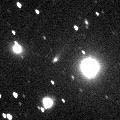
|
Although the CCD nuclear magnitude was reported so faint as 16.5-17 mag, it is actually bright as 15.7 mag (June 26, Giovanni Sostero). It was visible visually as 13.8 mag when it located high (July 28, Seiichi Yoshida), but no visual observations have been reported recently since it got somewhat lower. It will be too low to observe from December to January, but it will be observable as 15 mag again in 2006 summer.
Date(TT) R.A. (2000) Decl. Delta r Elong. m1 Best Time(A, h)
Nov. 5 17 25.89 16 30.3 4.224 3.696 51 15.3 20:07 (106, -5)
Nov. 12 17 33.29 14 44.6 4.280 3.694 48 15.3 20:17 (101,-10)
|
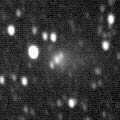
|
It kept bright as 12 mag from June to August, however, it faded down to 13.0 mag on Sept. 8 (Seiichi Yoshida). It faded down to 15.7 mag on Oct. 19 by CCD observations (Mitsunori Tsumura). It keeps locating around the same altitude after this until January when it will be fainter than 18 mag.
Date(TT) R.A. (2000) Decl. Delta r Elong. m1 Best Time(A, h)
Nov. 5 20 24.81 -15 27.3 1.679 1.830 82 15.4 20:07 (108, 49)
Nov. 12 20 40.98 -14 6.8 1.774 1.864 79 15.7 20:17 (106, 44)
|
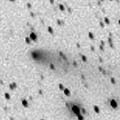
|
It was 16.8 mag at the discovery in May (May 20, R. H. McNaught). Then it brightened rapidly, and became visible visually as 13.7 mag (Sept. 3, Edwin van Dijk). Because it moves in the northern sky, it keeps locating high for a long time in the Northern Hemisphere. However, it will fade out rapidly after this, and will be fainter than 18 mag in early January.
Date(TT) R.A. (2000) Decl. Delta r Elong. m1 Best Time(A, h)
Nov. 5 4 54.01 51 39.8 0.908 1.757 135 15.4 1:58 (180, 3)
Nov. 12 4 47.20 52 34.5 0.919 1.794 140 15.6 1:24 (180, 2)
|
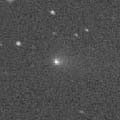
|
It was observed as 17.0 mag on July 10. Then it brightened as expected and reached to 15.0 mag on Oct. 1 (Mitsunori Tsumura). It has shown unstable change of brightness in its past appearance, however, it seems stable in this return. It keeps 15 mag until December. It is also visible visually as 13.5 mag (Oct. 24, Seiichi Yoshida).
Date(TT) R.A. (2000) Decl. Delta r Elong. m1 Best Time(A, h)
Nov. 5 0 10.27 -6 35.7 1.570 2.390 136 15.5 21:11 (180, 62)
Nov. 12 0 11.03 -6 22.5 1.620 2.380 130 15.6 20:44 (180, 61)
|

|
It brightened from 19 to 17 mag during a half of a year from summer to winter in 2004. The brightness evolution was rather faster than that of a typical comet. It had been very low for a while, but now it is getting higher again. It was 17.1 mag on Sept. 12 (Yuji Ohshima), as bright as expected. It will be observable in good condition as 16 mag for a long time until next spring.
Date(TT) R.A. (2000) Decl. Delta r Elong. m1 Best Time(A, h)
Nov. 5 10 9.83 55 33.5 4.918 5.031 90 16.3 3:20 (210,-13)
Nov. 12 10 18.39 56 14.0 4.834 5.024 95 16.2 3:11 (208,-13)
|
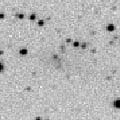
|
It was 13.6 mag on May 12, as bright as expected (Michael Mattiazzo). After that, no successful observations were reported for a while even when the comet became locating high also in the Northern Hemisphere. Actually, it was 17.1 mag on Sept. 3 (Ken-ichi Kadota). It seems the comet faded faster than expected. But it will keep 17 mag for a while.
Date(TT) R.A. (2000) Decl. Delta r Elong. m1 Best Time(A, h)
Nov. 5 5 13.48 9 3.3 1.883 2.734 142 16.4 2:17 (180, 46)
Nov. 12 5 7.40 8 54.4 1.874 2.775 149 16.5 1:44 (180, 46)
|

|
First return of a new periodic comet discovered in 1998. The condition is very good and it becomes brighter in this appearance than at the discovery. It was recovered in July at 19.5 mag, as bright as expected. Then it brightened as expected, and reached to 16 mag in September. It keeps locating high as 16 mag still in early November, but it will be fainter than 18 mag at the end of 2005.
Date(TT) R.A. (2000) Decl. Delta r Elong. m1 Best Time(A, h)
Nov. 5 21 50.08 -1 52.3 0.785 1.426 106 16.5 20:07 (148, 52)
Nov. 12 22 1.61 2 1.0 0.830 1.430 103 16.6 20:17 (142, 46)
|
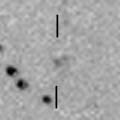
|
It was 16.8 mag on Sept. 9 (Yuji Ohshima). It keeps good condition for a long time. But it will fade out after this, and will be fainter than 18 mag in early January.
Date(TT) R.A. (2000) Decl. Delta r Elong. m1 Best Time(A, h)
Nov. 5 0 30.88 26 42.8 1.155 2.064 147 16.8 21:31 (180, 28)
Nov. 12 0 33.52 25 15.1 1.194 2.073 143 16.9 21:07 (180, 30)
|
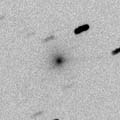
|
It was recorded as an asteroid at the discovery in 2002. It returned again now, and the faint tail was detected and it revealed to be a comet in fact. It passed very close by the earth in August, brightened rapidly from 15 mag to 12 mag. It brightened furthermore in September when appearing in the morning sky again, and reached to 10.3 mag on Sept. 14 (Juan Jose Gonzalez). Although it was diffuse in August, it became strongly condensed in September. However, now it is fading very rapidly. It faded down to 12.3 mag on Oct. 7 (Juan Jose Gonzalez) and 13-14 mag on Oct. 15 (Michael Jager). It is already too faint to see visually.
Date(TT) R.A. (2000) Decl. Delta r Elong. m1 Best Time(A, h)
Nov. 5 11 17.19 -3 13.1 1.322 1.049 51 16.8 3:20 (264, 14)
Nov. 12 11 30.64 -4 22.1 1.368 1.138 54 17.6 3:11 (264, 16)
|
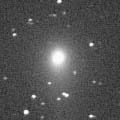
|
Getting higher again in the morning sky. It will be fading slowly around 17 mag in winer.
Date(TT) R.A. (2000) Decl. Delta r Elong. m1 Best Time(A, h)
Nov. 5 12 57.65 35 46.4 4.636 4.178 56 16.9 3:20 (244,-27)
Nov. 12 13 3.79 35 21.0 4.632 4.237 60 17.0 3:11 (243,-24)
|
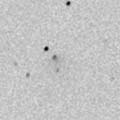
|
It passes the perihelion in 2006 February. But it is outside of Jupiter's orbit. So it keeps 17 mag for a long time. Because it moves in the northern sky, it keeps locating high and observable in good condition until 2006 summer.
Date(TT) R.A. (2000) Decl. Delta r Elong. m1 Best Time(A, h)
Nov. 5 14 21.56 65 50.2 6.899 6.824 81 17.0 3:20 (209,-44)
Nov. 12 14 30.43 65 23.1 6.863 6.820 83 17.0 3:11 (210,-43)
|

|
It reached to 17 mag in 2004 autumn. It will be observable as 17 mag in good condition in winter again.
Date(TT) R.A. (2000) Decl. Delta r Elong. m1 Best Time(A, h)
Nov. 5 7 52.44 17 25.3 2.748 3.165 105 17.2 3:20 (208, 33)
Nov. 12 7 54.65 17 4.8 2.666 3.175 112 17.2 3:11 (203, 35)
|

|
The component C was recovered on Oct. 22 as 19.3 mag (C. W. Hergenrother). It will pass only 0.08 AU from the earth on May 12, and will be so bright as 2 mag. Expected to be visible with naked eyes. It keeps observable in good condition all through the encounter in May. Brightening rapidly, and will be visible visually as 14 mag in January. The components B and E have not been recovered yet. The component B will reach to 7 mag in May. The component E may have already disappeared because it faded before the perihelion passage in its last appearance in 2001.
Date(TT) R.A. (2000) Decl. Delta r Elong. m1 Best Time(A, h)
Nov. 5 11 12.54 15 34.9 2.979 2.629 60 17.4 3:20 (248, 4)
Nov. 12 11 22.75 14 52.1 2.841 2.575 64 17.2 3:11 (247, 6)
|
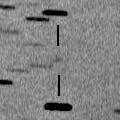
|
It was recovered at 17.3 mag on Sept. 7 (Filip Fratev), as bright as exepcted. It keeps 17.5 mag until December. Although it had been low, it will be higher after this.
Date(TT) R.A. (2000) Decl. Delta r Elong. m1 Best Time(A, h)
Nov. 5 10 22.32 17 29.7 1.874 1.825 71 17.3 3:20 (239, 12)
Nov. 12 10 37.74 17 34.3 1.828 1.846 75 17.3 3:11 (238, 12)
|
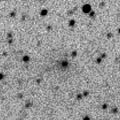
|
It will be at opposition again between autumn and winter, and observable at 17.5 mag locating high.
Date(TT) R.A. (2000) Decl. Delta r Elong. m1 Best Time(A, h)
Nov. 5 4 1.00 18 5.8 3.552 4.500 160 17.4 1:05 (180, 37)
Nov. 12 3 56.16 17 59.0 3.534 4.509 168 17.4 0:33 (180, 37)
|
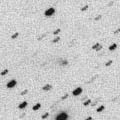
|
It was expected to reach to 13 mag in 2005 spring at the perihelion passage. However, the brightness evolution was very slow actually and it was only 14.5 mag at best. Now it is getting higher again in the morning. Because the current distance is almost same as that at the discovery, it is expected to be as bright as at that time, around 17.5 mag. But if it is fading as a typical comet after the perihelion passage, it can be already fainter than 18 mag.
Date(TT) R.A. (2000) Decl. Delta r Elong. m1 Best Time(A, h)
Nov. 5 8 11.64 4 42.1 2.947 3.241 98 17.6 3:20 (220, 42)
Nov. 12 8 2.42 4 54.6 2.866 3.298 107 17.6 3:11 (212, 45)
|

|
Now it is around the aphelion. However, it will be at opposition in early November and reach to 17.6 mag. It becomes brighter than 18 mag only in November.
Date(TT) R.A. (2000) Decl. Delta r Elong. m1 Best Time(A, h)
Nov. 5 2 50.00 40 31.0 1.462 2.398 155 17.7 23:49 (180, 15)
Nov. 12 2 31.71 39 3.2 1.459 2.402 157 17.6 23:03 (180, 16)
|

|
Fading slowly. It will be fainter than 12 mag. It keeps locating high.
Date(TT) R.A. (2000) Decl. Delta r Elong. m1 Best Time(A, h)
Nov. 5 0 28.07 59 48.8 5.779 6.458 129 17.7 21:28 (180, -5)
Nov. 12 0 22.76 58 41.9 5.850 6.519 129 17.8 20:55 (180, -4)
|

|
New faint comet. It will be only 18 mag at best in November and December.
Date(TT) R.A. (2000) Decl. Delta r Elong. m1 Best Time(A, h)
Nov. 5 5 4.79 20 22.7 4.424 5.271 145 17.9 2:09 (180, 35)
Nov. 12 4 54.94 20 22.1 4.350 5.262 154 17.9 1:32 (180, 35)
|
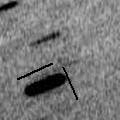
|
It was observed around 20 mag in early October, as bright as expected. It will be observable in good condition at around 17 mag from December to March.
Date(TT) R.A. (2000) Decl. Delta r Elong. m1 Best Time(A, h)
Nov. 5 9 27.58 15 10.3 1.652 1.823 83 18.1 3:20 (231, 22)
Nov. 12 9 41.91 13 31.2 1.577 1.808 86 17.9 3:11 (231, 24)
|
|
![]()
 73P/Schwassmann-Wachmann 3
73P/Schwassmann-Wachmann 3 171P/2005 R3 ( Spahr )
171P/2005 R3 ( Spahr ) 65P/Gunn
65P/Gunn C/2004 L1 ( LINEAR )
C/2004 L1 ( LINEAR ) (3200) Phaethon
(3200) Phaethon C/2001 Q4 ( NEAT )
C/2001 Q4 ( NEAT ) C/2005 R4 ( LINEAR )
C/2005 R4 ( LINEAR ) 60P/Tsuchinshan 2
60P/Tsuchinshan 2![]()































